
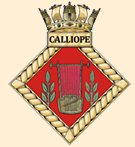
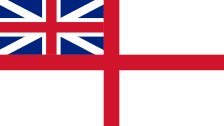
A 2,770 ton screw corvette, designed by Nathaniel Barnaby. The last of a line of 11 "protected cruisers" of the Comus class, she was always intended for service in the Pacific and Australian waters, and so was deliberately designed with a full 'barque' sailing rig, since the availability of fuel away from British shores could not be guaranteed. She was some 235 feet in length (between perpendiculars) and 44 feet 6 inch in extreme breadth. Launched by Lady Phipps Hornby on June 24th 1884 and commissioned in 1887, her design was optimised for distant cruising service, with a fouling-resistant coppered steel hull. She had - for their time - relatively powerful engines made in London by J. and G. Rennie, a famous firm of marine and heavy engineers. The engines could develop 3,000 horse power providing a speed of thirteen and three-quarter knots, or under a forced draught, nearly fifteen. At the time of the Hurricane, the ship's company amounted to 26 officers, 20 petty officers, 7 signallers, 130 Seamen, 36 Engine Room staff & Stokers, 34 others including stewards and cooks, and 37 marines, officers and men, plus a "guest of the Captain"; a total of 291 persons.
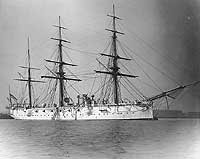
The propeller was driven by those two engines being supplied with steam from no less than six boilers and furnaces. The engines were "double-expansion" reciprocating units arranged "in-tandem" on the shaft, and had a design horsepower some 600 more than other ships of her class. Calliope was fortunate in being the eleventh and last of the class which included Champion, Cleopatra, Carysfort, Conquest, Curacoa, Constance, Cordelia, Canada and Calypso in addition to the class leader Comus, and benefited from a number of improvements as the ships were built over the period 1875 to 1884. Known variously as "C class cruisers", "armoured cruisers" and "protected cruisers" the ships were really a smaller derivative of the Shannon, the first British armoured cruiser of the Royal Navy. Fred T. Jane (author of Jane's Fighting Ships) ascribes Calliope as Comus class, though most other reference sources seem to call her the second of the Calypso class. All eleven vessels are difficult to distinguish.
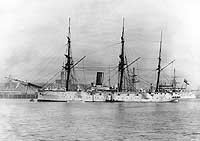
The transverse frames were iron, but the hull was designed in steel, that is the skin plating, transverse bulkheads, longitudinal skeleton, and so on. The hull was encased either side in wood, and her bottom was sheathed in a copper alloy to resist the attentions of fouling, and so reduce the need for prolonged stays in dry dock. More precisely, the material was known as "Muntz Metal", a mixture of copper and zinc. The teredo, known as shipworm but technically a mollusc, was an absolute scourge to wooden vessels in the tropics. Her bow, confidently jutting forward like the set and prominent chin of some powerful boxer, carried an enormous brass forging underwater ram, and a similar material was used for her stern and body posts. The bow led into graceful hull lines which were interrupted only by gun port sponsons, to lead to the curved stern overhanging her single large screw.
She was provided with four 6 inch breech-loaders on sponsons 2 on each side fore and aft, twelve 5 inch breech-loaders mounted on Vavasseur carriages on the upper deck, six quick-firing Nordenfelt and four Gardner guns. The largest projectile weighed some 100 pounds, and required a 42 pound powder charge. The "6 Inch B.L. Mark I", a 6 inch Bore, Breech Loading gun, was first fitted to H.M.S. Rover in around 1880. The Mk. II was introduced on a large number of ships a little later, including the Comus class. The Mk. II 6" Bore had a length of 26 calibres, weighed 4 tons and a muzzle velocity of 1,672 feet per second for its 100 lb shell. Calliope also carried six torpedoes which could be despatched from a single tube located on each side of the ship.
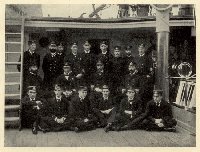
HMS Calliope left Britain on 1st March 1887 for her first commissioning cruise and the China Station by way of the Cape of Good Hope and Singapore. Her Captain was Henry Coey Kane, an Irishman, the son of the famous scientist Sir Robert Kane. Born 1843, Captain Kane had a distinguished career in the Royal Navy, having been wounded during the Sudan Campaign, and had received consistent praise from their Lordships. Click the image to view a photograph of Kane and his officers on the deck of HMS Calliope. Detached by special request to the Australia Station, the vessel was eventually sent to Samoa to relieve HMS Royalist and continue the Royal Navy's presence in the deteriorating political climate which, until the hurricane intervened, had seemed destined to pit German and American naval units against each other in what might easily have become the first world war.
It has proved very difficult to definitely identify the officers in the photograph. Captain Kane is, of course, seated in the middle 3rd from left, easily recognised from his beard and Captain's cap. Assuming the personnel to be those on the ship at Apia (reasonably good, as Kane left the ship at the end of the commissioning voyage), I am guessing from his garb that the person seated far left is the ship's chaplain, the Reverend Arthur C. Evans M.A. Kay Saville-Smith is certain the midshipman seated on the deck at far left to be her great-grandfather Frank Brandt, and Rebecca Ditchburn thinks that the gentleman standing third left may be her great-grandfather, Staff Paymaster Beechey Rogers. I should guess that seniority would place the First Lieutenant, Robert Kyle McAlpine on the captain's right (i.e. second left centre row) and possibly the Navigating Lieutenant, Henry Pearson on his other side, far right? I have an image of Lieutenant Carter in later life, but cannot match him to anyone. It is quite possible that the gentleman standing third from right at the back is wearing a cap of the Royal Marine Light Infantry, but I am not sufficiently skilled in uniform recognition to be sure, but as the vest is significantly different to the others, I will guess him to be Lieutenant R.M.L.I. Alfred E. Marchant.
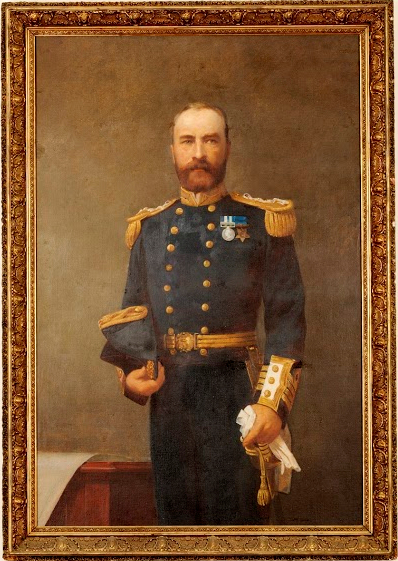
|
Captain Henry Coey Kane, 1843-1917The image is a photograph of a painting of Captain Henry Coey Kane. There seems to be wording along the bottom edge, but I cannot read it from the photograph, and so the artist is not known to me. The painting resides in the refectory of Castleknock College, Dublin, Eire, and is reproduced here with their kind permission. I have tried to research the uniform in order to determine both the Rank and the date the painting was made, so far, without absolute success, but I am fairly confident it is the uniform of "Captain" circa 1890. One of the medals is the "Khedive's Star", the other probably the "Alexandria Medal", so it is definitely after 1882. If you check the images of my great-grandfather's copies of these medals (he was in the same action), you will see the ribbons sort of match. The key uniform identifiers are: the belt, the epaulettes, the sleeves, the hat, and maybe the collar and jacket buttons. The sleeve shows four bands, which I think does indicate "Captain". What should be the best hope, the Royal Maritime Museum at Greenwich, does not have anything that perfectly matches, at least not currently digitized.If any visitor can put me right about this, I would be most grateful. Please use the contact form to let me know. Please do not use this image without requesting permission to do so from St. Vincent's College, Castleknock, Co. Dublin, Eire. |